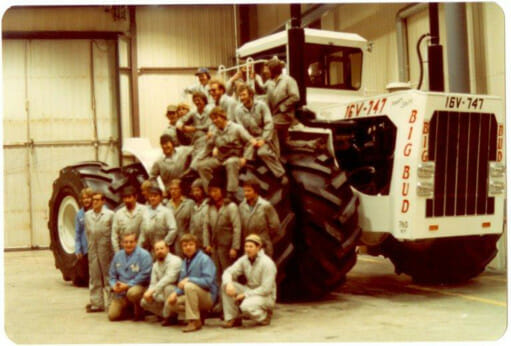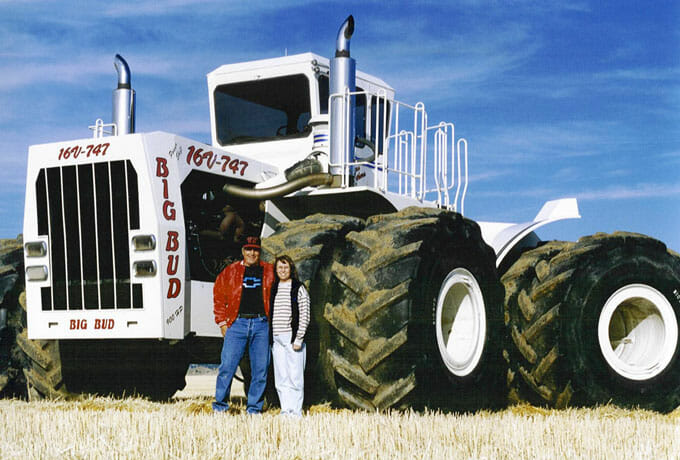This Tractor Is Freaking Huge
Ron Harman never intended to build the biggest farm tractor in the world. But sometimes things just work out that way.
A turn of the ignition says all the machine needs to say. Sixteen pistons vibrate a body that weighs over 100,000 pounds. Twin plumes of black diesel smoke flee silver exhaust pipes above the cab. When linked with a cultivator, the machine can deep rip 36 inches deep at a rate of 20 acres per hour. This thing eats name-brand farm equipment for breakfast.
Ron Harman never intended to build the biggest farm tractor in the world. “It was really built because of a need,” says Harman, who still makes a living building and refurbishing custom tractors. The Rossi Brothers, cotton farmers from Old River, Calif., came to Harman’s Northern Manufacturing Co. (now Big Equipment L.L.C.) for a machine that would let them quickly deep rip a third of their ground once a year. Whatever the company came up with would have to haul an 35,000-pound, 80-foot cultivator through tough western soil without a hiccup.
The final product stood as a testament to the late 1970s farm boom. Rising commodity prices and increased farm sizes pushed farmers to invest in bigger, more efficient pieces of equipment. When John Deere or Massey Ferguson couldn’t meet the requirements, farmers looked to Harman for custom-built machines.
Since no one in the agricultural industry made parts for a tractor that big, the 85,000-pound Clark axles picked for the order, along with just about every other part on the tractor, came from either the mining or construction industries. Even then, parts had to be beefed up. Unlike a coal loader, the torque and stress on the machine would be continuous.

Realizing the Big Bud was something of a test bed for larger-scale tractors, Northern Manufacturing built a frame that could handle available parts from a range of manufacturers. “The best thing about the tractor was that if any of those components wouldn’t have worked, we hadn’t painted our self into a corner,” says Harman. Versatile engineering, not the ridiculous claim of 950 horsepower, has always been the main point of Harman’s pride for the Big Bud 747.
The craftsmanship helped the tractor keep running — save a few pit spots — from 1977 until its recent retirement. After serving at farms in California and Florida, Randy and Robert Williams brought the tractor to their farm in Big Sandy, Montana and restored it to near-mint condition. They only agreed to lend the tractor to the Heartland Museum in Clarion, Iowa after opting for no-till farming.
“We are tickled to death to own it,” says Randy Williams. Some are tickled to death just to drive it. John Harvey, a tractor aficionado, found the experience so compelling he wrote a coffee table book full of facts, stories and pictures on the Williams Brothers’ tractor.
For the gear heads out there, here are the stats on the tractor.
Components
Torque Converter: Twin Disc 8FLW-1801
Type: 18in. (45.72 cm) circuit with lock-up clutch
Blading: MS-380
Forward speeds: 6
Reverse speeds: 1
Axles: Clark D-85840
Brakes: 26 in x 8in (66.04 cm x 20.32 cm) airbrakes, all wheels
Hydraulic system type: Load-sensing system allowing maximum pump flow to steering and implement valve.
Maximum flow: 65 gal/min (245.96 liters/min)
Tank Capacity: 150 Gallons (567.64 liters)
Relief pressure: 2000 psi
Implement valve: 4-spool open center, 60 gal/min (227.05 liters/min)
Steering: Orbital motor with 100 cubic inch (1.64 liters) displacement per steering wheel revolution
Steering cylinders: Double action dual cylinders, 4.5 inch (11.43 cm) bore
Weight
95,000 lb (38,636 jg) estimated shipping weight
130,000 lb (49,895 kg) ballasted weight
Dimensions
Wheelbase: 16 feet, 3 inches (4.95 meters)
Height (top of cab): 14 feet (4.27 meters)
Length (frame): 27 feet (8.23 meters)
Length (end of drawbar): 28 feet, 6 inches (8.69 meters)
Width (over fenders): 13 feet, 4 inches (4.06 meters)
Width (over duals): 20 feet, 10 inches (6.35 meters)
Follow us

This work is licensed under a Creative Commons Attribution-NoDerivatives 4.0 International License.
Want to republish a Modern Farmer story?
We are happy for Modern Farmer stories to be shared, and encourage you to republish our articles for your audience. When doing so, we ask that you follow these guidelines:
Please credit us and our writers
For the author byline, please use “Author Name, Modern Farmer.” At the top of our stories, if on the web, please include this text and link: “This story was originally published by Modern Farmer.”
Please make sure to include a link back to either our home page or the article URL.
At the bottom of the story, please include the following text:
“Modern Farmer is a nonprofit initiative dedicated to raising awareness and catalyzing action at the intersection of food, agriculture, and society. Read more at <link>Modern Farmer</link>.”
Use our widget
We’d like to be able to track our stories, so we ask that if you republish our content, you do so using our widget (located on the left hand side of the article). The HTML code has a built-in tracker that tells us the data and domain where the story was published, as well as view counts.
Check the image requirements
It’s your responsibility to confirm you're licensed to republish images in our articles. Some images, such as those from commercial providers, don't allow their images to be republished without permission or payment. Copyright terms are generally listed in the image caption and attribution. You are welcome to omit our images or substitute with your own. Charts and interactive graphics follow the same rules.
Don’t change too much. Or, ask us first.
Articles must be republished in their entirety. It’s okay to change references to time (“today” to “yesterday”) or location (“Iowa City, IA” to “here”). But please keep everything else the same.
If you feel strongly that a more material edit needs to be made, get in touch with us at [email protected]. We’re happy to discuss it with the original author, but we must have prior approval for changes before publication.
Special cases
Extracts. You may run the first few lines or paragraphs of the article and then say: “Read the full article at Modern Farmer” with a link back to the original article.
Quotes. You may quote authors provided you include a link back to the article URL.
Translations. These require writer approval. To inquire about translation of a Modern Farmer article, contact us at [email protected]
Signed consent / copyright release forms. These are not required, provided you are following these guidelines.
Print. Articles can be republished in print under these same rules, with the exception that you do not need to include the links.
Tag us
When sharing the story on social media, please tag us using the following: - Twitter (@ModFarm) - Facebook (@ModernFarmerMedia) - Instagram (@modfarm)
Use our content respectfully
Modern Farmer is a nonprofit and as such we share our content for free and in good faith in order to reach new audiences. Respectfully,
No selling ads against our stories. It’s okay to put our stories on pages with ads.
Don’t republish our material wholesale, or automatically; you need to select stories to be republished individually.
You have no rights to sell, license, syndicate, or otherwise represent yourself as the authorized owner of our material to any third parties. This means that you cannot actively publish or submit our work for syndication to third party platforms or apps like Apple News or Google News. We understand that publishers cannot fully control when certain third parties automatically summarize or crawl content from publishers’ own sites.
Keep in touch
We want to hear from you if you love Modern Farmer content, have a collaboration idea, or anything else to share. As a nonprofit outlet, we work in service of our community and are always open to comments, feedback, and ideas. Contact us at [email protected].by Sam Brasch, Modern Farmer
November 21, 2013
Modern Farmer Weekly
Solutions Hub
Innovations, ideas and inspiration. Actionable solutions for a resilient food system.
ExploreExplore other topics
Share With Us
We want to hear from Modern Farmer readers who have thoughtful commentary, actionable solutions, or helpful ideas to share.
SubmitNecessary cookies are absolutely essential for the website to function properly. This category only includes cookies that ensures basic functionalities and security features of the website. These cookies do not store any personal information.
Any cookies that may not be particularly necessary for the website to function and are used specifically to collect user personal data via analytics, ads, other embedded contents are termed as non-necessary cookies.

just interested in modern farming